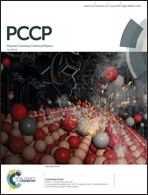Rupture of amorphous graphene via void formation
Abstract
Apart from its unique and exciting electronic properties, many sensor based applications of graphene are purely based on its mechanical and structural properties. Here, we report a numerical and analytical study of a void in amorphous (small domain polycrystalline) graphene, and we show that the energetics of the void is a balance between the line tension cost versus the increased area gain. Using the concepts of classical nucleation theory, we show that the critical radius of a void formed in amorphous graphene at constant pressure is simply the ratio of the line tension at the void and the applied pressure. The values of the critical radius of the void for flat and buckled graphene are 3.48 Å and 3.31 Å, respectively, at 2 eV Å−2 pressure. We also show that the dominant finite size correction to the line tension is inversely proportional to the radius of the void in both flat and buckled cases. In contrast to conventional wisdom, with the help of a simple analytical model, we find that the shear modulus sets the lower limit of the line tension in the samples. This makes our study relevant for other two-dimensional amorphous materials such as h-BN, phosphorene, borophene, and transition metal dichalcogenides. Our results are useful for the better understanding of polycrystalline graphene under tension and therefore they have direct implications in the very fascinating field of strain engineering known as “straintronics” to manipulate or improve the properties of graphene.

- This article is part of the themed collection: 2018 PCCP HOT Articles


 Please wait while we load your content...
Please wait while we load your content...